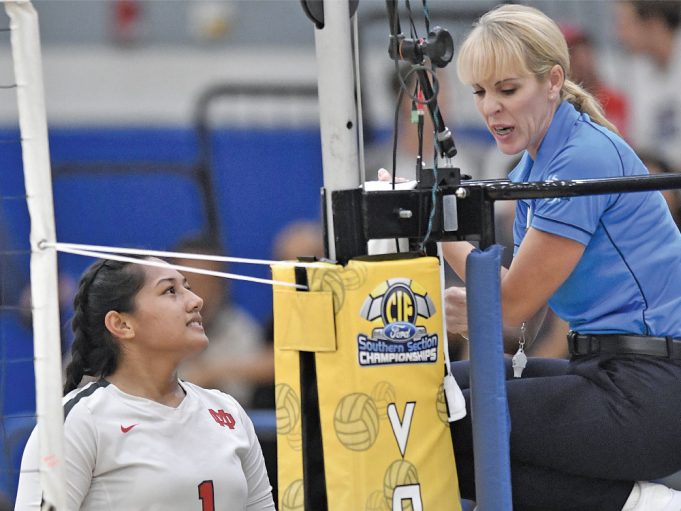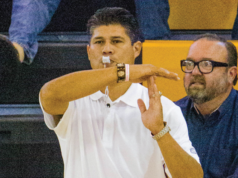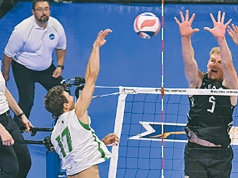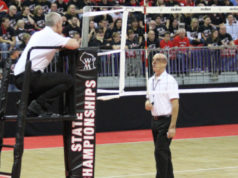As crazy as this might sound, have you ever thought of volleyball referees being in the customer service business? One might advance the notion that a lot more is required of referees than of a customer service agent. Both have a customer to please after all, don’t they? Except referees have many more customers to please and they’re divided into two opposing teams.
Coaches are at the helm of advocating for their team, but they may be a little harder than the customer who’s trying to get a free meal after encountering “bad service.” There are many ways to tackle communication without words being lost in volleying, pun intended, back and forth.
Body language, tone of voice, eye contact — there are a monumental number of things to consider when trying to calm down an irritated coach. Every situation is unique and requires a thought-out response — which must be put together in a matter of seconds, if not a few tenths of a second.
Some say communication is a masterful art as opposed to science. Communication with coaches and players blends the two into a wild science experiment. That’s because what one referee says to a coach might not work for another referee. In essence, key words and phrases are not something that can be duplicated by all officials, nor something that works in every situation.
This is something that requires practice. The next time you’re speaking to someone, consider analyzing parts of that conversation. Where were your hands? Were you making direct eye contact with the person? Having hands at your sides could make you appear disinterested but overly exuberant hands draw an opposite, but still negative, effect.
The following are a few tips to help you craft your own strategy when communicating with players and coaches.
Listen before you speak.
We’re all guilty of not doing this. We try and head off a potential issue by rattling off an explanation to the head coach first about who may or may not have touched the ball before it went flying out of bounds. But in reality, he or she wanted an explanation on an earlier part of the play. The same applies when a playing captain approaches the stand. No one needs to remind you what happens when you assume.
Key in on what’s happening.
If you’re working for multiple conferences or leagues, it might be admittedly difficult to keep track of how teams are doing, but it’s worth giving recently played games a quick look. Is a team that was expected to be at the top of the standings coming off a five-game skid? Knowing this type of information can help you figure out what a coach or player is thinking, or even how they’re feeling.
Do comments require a response?
As you’re listening, you’re likely working on drumming up a response. If a coach is venting at the end of a rally, there’s probably not a reason to intervene unless it’s disrupting the match. That’s where the phrase, “Answer questions, not statements,” can play to our advantage as referees. But there comes a certain point in time when statements become enough. “That’s a double. That’s a lift. That’s a foot fault.”
Preventive.
It’s a word that has appeared hundreds of times in this magazine and has become even more important in today’s game. The first referee calling over the playing captain or the second referee moving toward a coach to prevent a cross-court spat with the first referee can go a long way.
Outstretched arms and confusion.
No one’s asking the second referee to hold up play every time a coach looks confused, but second referees can make themselves available to answer a question. Without assuming what the coach might be puzzled about, second referees can ask the coach if he or she has a question before proceeding.
Enough is enough.
Two-way communication between the first referee and playing captains and the second referee and head coaches (or assistant coaches when allowed by rule) should be encouraged. That two-way communication cannot become one-way if a coach or captain goes beyond what is allowed by rule. If a coach crosses the line, it’s important for the second referee to put up a boundary using a stop sign with two hands to show the conduct must stop. Sending a clear message to coaches or players that their actions are not acceptable is essential to managing a match. This does not preclude referees from skipping steps in the warning/sanction process if warranted.
Sanctions are not a sign of failure.
Nearly 63 percent of volleyball officials who responded to NASO’s 2017 National Officiating Survey indicated they believe sportsmanship in the sport has worsened. For the benefit of the sport, it’s essential that referees take care of misconduct. Do not be part of a crew that decides to let unsportsmanlike conduct slide, because the next crew will be forced to deal with it. NASO’s survey also revealed nearly 93 percent of volleyball officials who responded did not regret a decision to eject a coach, but 60 percent of officials regretted a decision not to eject a coach.
If you’re concerned about losing matches, consider opening a dialogue with your assigner or association about how to tackle this issue. No one will ever say to go looking for things to sanction or eject players and coaches on, but to blatantly ignore problems would be just as wrong.
Altogether, the goal is to avoid these problems, and being a strong communicator can prevent escalating situations from getting worse.
Find your communication strategy and figure out what works best for you.
Again, this is not a cookie-cutter approach where one size fits all, but talking to other officials and having pregame and postgame discussions about what does and doesn’t work during a match will benefit everyone.
What's Your Call? Leave a Comment:
Note: This article is archival in nature. Rules, interpretations, mechanics, philosophies and other information may or may not be correct for the current year.
This article is the copyright of ©Referee Enterprises, Inc., and may not be republished in whole or in part online, in print or in any capacity without expressed written permission from Referee. The article is made available for educational use by individuals.


















